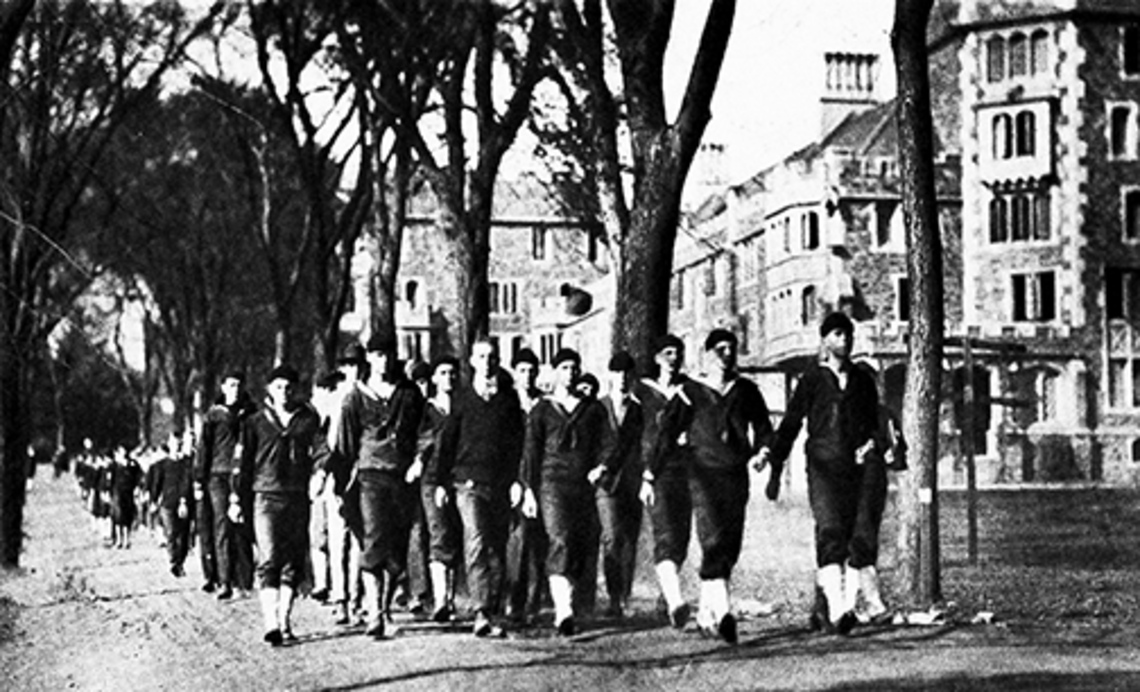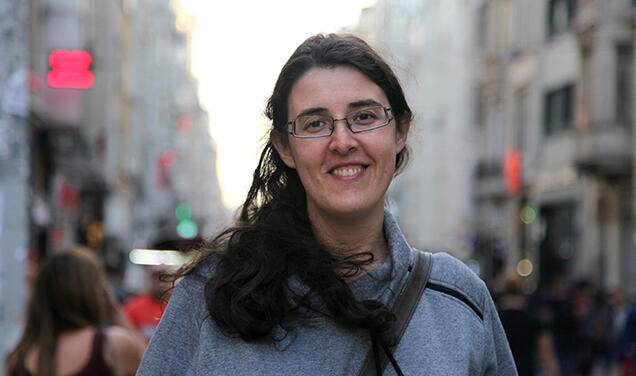
The world must be made safe for democracy.
— President Woodrow Wilson 1879, April 2, 1917
Deadly small-arms fire poured into the column. Realizing the danger to the column as it lay motionless, Lt. Col. Page fought his way to the head of the column and plunged forward into the heart of the hostile position. His intrepid action so surprised the enemy that their ranks became disordered and suffered heavy casualties. Heedless of his safety, as he had been throughout the preceding 10 days, Lt. Col. Page remained forward, fiercely engaging the enemy single-handed until mortally wounded.
— Medal of Honor citation, Lt. Col. John U.D. Page ’26, April 25, 1957
Any Princeton history column has to address the centennial of the pivotal World War I, be it from the viewpoint of our ubiquitous friend Tommy Wilson 1879, from those directly involved like the golden boy Hobey Baker 1914, or from the University administration that felt the duty to serve the cause of the military during the war, and then provide a stable home – literally – to a large Army ROTC program immediately afterward and, in modified form, ever since.
Because, for the umpteenth time in the last 95 years, ROTC is back in the local headlines as the Navy revives its program at Princeton, let’s start from there and see where we end up in considering the place of an institution of open learning in the realm of armed conflict. I’ve said before in these pages that it seems reasonable to regard war in the modern economic age as the abject failure of diplomacy (if not rationality, period), and so the desirability of aligning a liberal-arts college directly with the military seems at first strategic glance counterintuitive. Millions for the Wilson School, not one cent for the Pentagon, if you will. Of course, life isn’t rational, as we each know from painful experience. Korea, Vietnam, Granada (Granada??), Kuwait, Somalia, the Balkans, Iraq, Afghanistan: Wilson’s good-faith attempt to end all wars has proven the gateway to a colossal mess even if you count World War II as a simple continuation of the first one.
Ergo, there remains a crying need for military talent and leadership – not the same thing, by the way – in the United States, as long as we feel bound to act on some level as the world’s good cop, spending untold billions and precious lives on other peoples far away in an attempt to supposedly then leave them alone (what Wilson in his 1917 address to Congress called “the rights of nations great and small and the privilege of men everywhere to choose their way of life”). So the tactical question always seems to be: If you’re inevitably going to have a military officer corps, shouldn’t Princetonians be included?
If so, ROTC is one way to do it, although it needs to be noted that nothing prohibits any alum from enlisting for the service, then going through Officer Candidate School (a rare progression in the current all-volunteer military). But ROTC tilts the odds toward the armed services, by allowing the student to qualify as officer material while getting an undergrad degree, and getting paid a bit to do it. Plus, in 1919, when it got up and running following World War I, the men of Princeton got an added incentive: horsies.
View video from the Princeton University Archives
Princeton had been the first college with a polo team in 1903, but it ran afoul of the high cost of equine maintenance – and possibly Wilson’s novel idea as new University president that students should study – and was dormant until the War department opened the Field Artillery unit in 1919 and supplied gratis a string of polo ponies. This was a gentle anachronism after World War I, but by 1940 – when there were still 70 Army horses parading alongside the Armory – the German Panzer divisions and Messerschmitts overrunning Europe made it seem dangerously myopic. This brings up a recurring question about ROTC programs: Do they amount to kids playing soldier/sailor/airman with military surplus toys, or are they a real preparation for war and military life?
Either way, Princeton ROTC grads died in World War II, Korea, and Vietnam – including Lt. Col. John Page ’26 while earning a Congressional Medal of Honor – even as a number of questions repeatedly arose about the propriety, status, and operation of the program itself. Grumbling about the validity of the War Department’s military-science courses in the Princeton curriculum started in PAW as early as 1927, and unease from the faculty, who had no control over the rigor of the courses or the military officers assigned to teach them, not long thereafter. ROTC was suspended for World War II (and the artillery/polo horses put out to pasture) in favor of War Department military training, and when it resumed afterward was joined by Naval and Air Force units as the Cold War gathered momentum. Having peaked at about 600 students in the 1920s, ROTC, now fueled by draft deferments for participants, soared to 1,100 (more than 30 percent of the student body) during Korea in 1951. But that just reinforced the academic friction, and as students became less willing to give up an academic course to take it, and Congress gave draft exemptions to all undergrads, numbers dropped rapidly until Vietnam knocked the bottom out. By the time the faculty finally voted to withdraw their academic status in 1969, the three military units combined had 113 members, not much payoff to the Pentagon for the investment and skilled personnel it devoted to the programs.
A vote by the faculty and student body, approved by the trustees, to end ROTC followed the Cambodian invasion of 1970 but quickly was reversed. However, the Navy and Air Force wanted no part of the extracurricular-only rules laid down by the faculty, so only the Army remained – no longer artillery, and reconstituted as today’s Tiger Battalion. With the draft ended in 1973, ROTC became an extremely niche operation, offering military instruction and some scholarship bucks to those who wished it, but generally well outside the mainstream of student life. By the mid-’80s, the University’s explicit LGBT nondiscrimination policy clashed with the military, and the open conflict persisted awkwardly until the final collapse of “don’t ask, don’t tell” in 2011. No other extracurricular organization with such a policy would have been allowed on campus.
But Tiger Battalion has persevered, and three members of the Class of 2014 were commissioned as second lieutenants on graduation in June.
So the most recent Princetonian’s death in the military during wartime was in 1970. Which seems on the face of it recent enough, especially considering the 355 who died in World War II, or the 21 from the Class of 1917 alone – 5 per cent of the self-proclaimed “War Baby” Class – who entered Princeton in a peaceful world in September 1913 and were dead by Armistice Day five years later.
But as I mentioned earlier, military leadership is a curious (and historically rare and ephemeral) thing. Sixty percent of current Army officers come from ROTC. Secretaries of State George Marshall and Colin Powell were ROTC grads. Defense secretaries Frank Carlucci ’52 and Donald Rumsfeld ’54 are alums of the Princeton NROTC program. Highly competitive and extremely rare promotions to flag officer (generals or admirals of various sorts) also arise from civilian institutions – as many as the record 47 from the University of Oregon. And then there are the three from the Princeton Class of 1970.
Say what?
Yes indeed, you recall the spare 113 souls in ROTC at the time. You recall the Cambodian invasion. We’ve spoken before of the Institute for Defense Analyses (IDA) demonstrations, suspension of academics, campus assemblies and anti-war activities in the late ’60s, and the complete restructuring of the University’s governance. From that tumult came – and “improbability” doesn’t do it justice – significant American military leadership, more flag officers (each now retired) than any living Princeton class. There’s NROTC alum Rear Admiral Kirk Unruh ’70, who served 33 years in the Navy and Reserve, with commands at sea, ashore, and at the Pentagon, most while serving in the University’s development office, where he’s now the recording secretary. (His impressive retirement ceremony, with Navy brass piled up all over the place, was held in the Faculty Room of Nassau Hall.) There’s Army ROTC alum Brig. Gen. Steve Xenakis ’70, a psychiatrist whose 28-year career included reform of the military’s health program and who subsequently has served as a Pentagon expert on PTSD and traumatic brain injury, and who has worked with Physicians for Human Rights in Guantanamo and elsewhere. And there’s Marine Maj. Gen. Drew Davis ’70, a graduate of the Corps’ Platoon Leader Course, who started out as an infantry officer, then over 38 years served in a series of both command and communications posts – in line with his civilian occupation as newspaper editor and journalism professor – culminating in service in the Afghan and Iraq wars, and as commander of Marines in Europe and Africa afterward. Since retiring, he heads the 60,000 member military Reserve Officers’ Association. These men and their careers are each remarkable, substantial, and unique.
If the Class of ’70’s contribution to the senior officer corps does nothing else, it shows that you can’t possibly tell where crucial leadership will arise. So if Princeton is to be fully of service to the nation, perhaps a bit more emphasis today on ROTC and military opportunities after graduation might be worthwhile (not to mention more action on veterans as potentially valuable students here). And yet … A veteran, especially in wartime, in good conscience has misgivings about enticing any human being into such a hideous, indefensible activity that does, to some extent, debase everyone who touches it. The more you have experienced, the more the conundrum presses in, without relief; just ask a war vet near you.
For example, me.













No responses yet